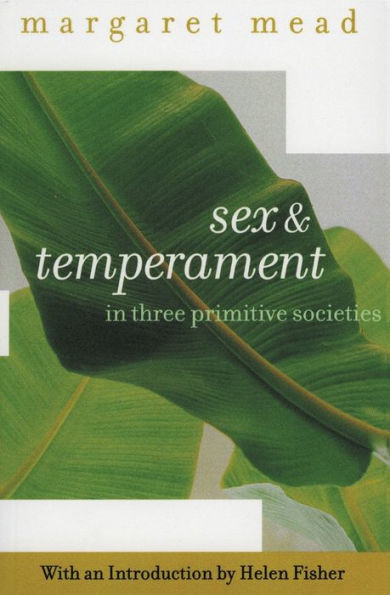Read an Excerpt
Chapter One
Mountain Life
The Arapesh-speaking people occupy a wedge-shaped territory that stretches from the sea-coast across a triple range of steep mountains, and down on the grass plains of the Sepik watershed to the west. The people on the beach remain in spirit a bush people. They have borrowed the custom of canoe-building from the neighbouring islands, but they feel much happier fishing not in the sea, but in the ponds that lie sheltered among the sago-swamps. They hate the sea-sand and build little palm-leaf shelters against its invasion. Forked sticks are set up on which carrying-bags can be hung and so kept out of the sand, and many palm-leaf mats are woven so that the people will not have to sit upon the sand, which is regarded as filthy. No such precautions are taken by the mountain people, who sit habitually in the mud without any feeling that it is dirt to be avoided. The beach-dwelling Arapesh live in large houses, fifty to sixty feet in length, built upon piles, with specially enclosed verandahs and decorated gable-ends. They cluster together in large villages, and the people go daily to their gardens and sago-patches, which are situated at no great distance from the village. These beach people are plump and well fed. The rhythm of their lives is slow and peaceful; there is plenty of food; pots and baskets, shell ornaments, and new dance-forms can be purchased from the passing canoes of the coastal trading peoples.
But as one begins to climb up the narrow slippery trails that extend to definite networks over the precipitous mountains, the whole toneof life changes. There are no more large villages, but only tiny settlements in which three or four families live, clusters of ten to twelve houses, some built on piles, the others built on the ground and so slightly constructed as to be hardly worth the name of house. The land is barren and infertile, the sago rare and planted instead of growing uncultivated in great natural swamps. The streams yield little except a few prawns, which are only occasionally worth fishing for. There are great areas of bushland in which there are no gardens, areas that are set aside for hunting tree-kangaroo, wallaby, opossum, and cassowary. But in these same regions the ancestors of the Arapesh have hunted for many generations, and game is rare and not to be counted upon. The gardens perch precariously on the sides of hills, presenting an almost insoluble problem in fencing, a problem with which the natives hardly attempt to deal. They merely resign themselves to the ravages of the pigs that have run wild in the bush.
The village pigs are not plump like the pigs in the beach villages, but skinny and more razor-backed, and so ill fed that they often die. When a pig dies the woman who was raising it is blamed for her greediness in eating not only all the taro but all of the taro-skin also, and sharing none of it with her pig. Gardens, sago-patches, hunting-grounds, are farther afield than on the beach, and the people accentuate the difficulties by electing always to work in small co-operative groups, now in one man's garden, now in another's. This necessitates an endless amount of walking about on the slippery precipitous paths and a great amount of shouting from mountain peak to mountain peak to send messages from one member of a family to another.
Level land is so scarce that there is seldom space to build even a small village. The biggest village in the mountain region was Alitoa, the village in which we lived for many months. It had twenty-four houses, in which eighty-seven people had residence claims; but these claims were only sporadically exercised and there were only three families who made Alitoa their main residence. Even with so few houses, some of them were built jutting out over the steep declivity that sloped away from the village upon all sides. When a feast is held, the visitors overflow the capacity of the village, dogs and children spill over the edges, and people must sleep on the wet ground underneath the houses because there is not room enough within the houses. When an Arapesh refers oratorically to a feast, he says: "We were burned by the sun and washed by the rain. We were cold, we were hungry, but we came to see you."
Collecting enough food and firewood to maintain any number of people in one place is also difficult. The hills surrounding a village have been combed for firewood for generations; the gardens are far away, and the women must toil for days to carry in supplies for a single day's feasting. Men carry nothing on these occasions except pigs and other heavy loads of meat and the large logs that are used for cigarette-lighting fires in the centre of the village. When they carry pigs, many relays of men combine, because the carrying-pole chafes their unaccustomed shoulders. But the women plod up and down the mountain paths with loads of sixty and seventy pounds suspended from their foreheads, sometimes also with a suckling baby in a bark sling at the breast. Their jaws are shut like rat-traps beneath the pressure of the headbands, giving their faces a grim forbidding expression that is seen at no other time and which contrasts with the gay, festive pig-carrying of the men, who go whooping and singing through the bush. But then it is appropriate that women should carry heavier loads than the men do, because women's heads, they say, are so much harder and stronger.
The manners of the mountain people proclaim at once that this is no country accustomed to the raids of head-hunters. Women go about unattended; pairs of tiny children stray along the paths...



